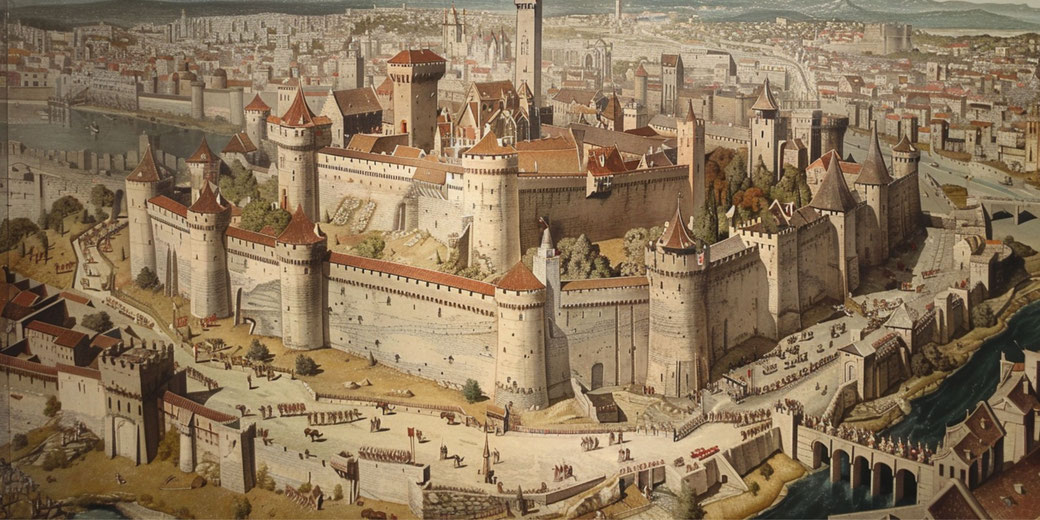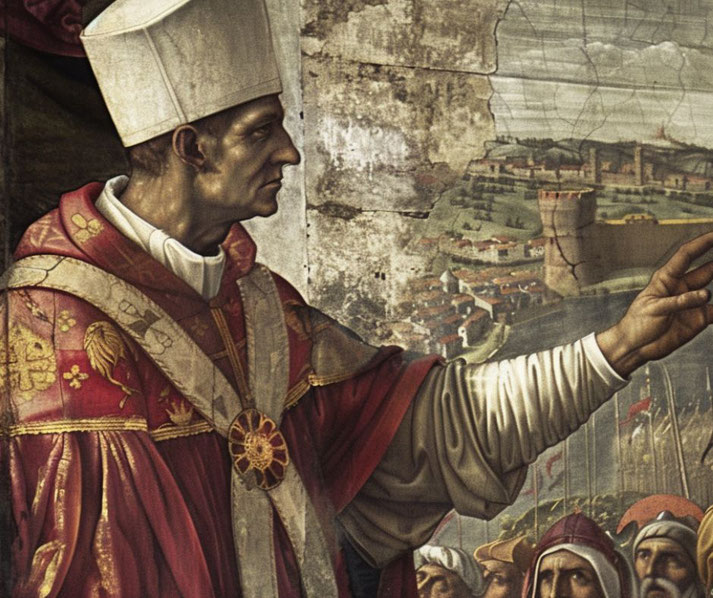The Albigensian Crusade and the Church’s ruthless suppression of heresy

In the early 13th century, the Catholic Church launched a brutal military campaign known as the Albigensian Crusade.
Unlike other crusades, which were sent against Muslim nations in the near east, this one occurred in the very heart of Christian Europe.
Its primary aim was to eliminate the Cathar heresy in southern France.
Countless lives were lost, and entire communities suffered long-term devastation. But perhaps most curious to modern observers is the role the notorious Inquisition played in the entire affair.
Who were the Cathar heretics?
The Cathars, also known as Albigensians, appeared in the Languedoc region of southern France sometime during the 12th century.
Their beliefs were considered 'dualistic’, as they saw the world as composed of two opposing principles: a good, spiritual realm and an evil, material world.
Specifically, the Cathars believed that the material world, including the human body, was created by an evil deity, often identified with the Old Testament God.
In contrast, they saw the New Testament God as a benevolent deity associated with the spiritual realm.
As a result of this, the Cathars encouraged its followers to focus entirely on the spiritual realm at the expense of their physical existence.
This version of Christianity contrasted starkly with the teachings of the Roman Catholic Church who taught that the physical and the spiritual were equally good and bad.
As a result, the Catholic Church labeled this Cathars as heretics, posing a threat to the wellbeing of those that adhered to their aberrant teachings.
But there were other teachings which caused concern in the Church as well. Central to Cathar doctrine was the concept of ‘consolamentum’, a form of spiritual baptism that considered essential for salvation.
This ritual was typically administered to believers at the end of their lives or when they were prepared to live as "Perfects".
Perfects were members of the sect who adhered to a strict ascetic lifestyle. The Perfects had to renounce all material possessions, abstain from teaching meat and sexual relations, and dedicated themselves to prayer and preaching.
As a result, they were particularly revered within the Cathar community.
The Cathars also held strange views on the afterlife. They believed in the transmigration of souls, which was a form of reincarnation.
They thought that souls were trapped in a cycle of rebirths in the material world until they achieved spiritual purity through the consolamentum.
Finally, the Cathar rejection of the Catholic Church's sacraments, priesthood, and hierarchy, along with their belief in two gods, led to their condemnation as heretics in the eyes of the Church hierarchy.

Why did the Albigensian Crusade begin?
Pope Innocent III, who ascended to the papacy in 1198, fervent sought the purity of the Christian faith.
He viewed the spread of Catharism in southern France with increasing alarm.
Initially, the pope wanted to combat the heresy through peaceful means. To this end, he sent his own legates to preach against the Cathars, but this proved largely ineffective.
The situation reached a critical point in January 1208, when the papal legate Pierre de Castelnau was assassinated near the town of Saint-Gilles.
The murder, widely attributed to the supporters of Count Raymond VI of Toulouse, a protector of the Cathars, became the key catalyst for Pope Innocent III's call to arms.
In direct response to the murder, Pope Innocent III declared a crusade against the Cathars, focusing on the Languedoc region.
He issued a series of papal bulls that called for the faithful knights of Europe to take up arms.
In return, the pope promised spiritual benefits, including indulgences and the remission of sins, to those who participated.
Additionally, in more practical terms, the crusade offered a new opportunity for nobles to seize lands and wealth by conquering the territories of heretical lords.
As a result, the Albigensian Crusade attracted a diverse coalition of forces, including nobles, knights, and commoners from various regions of Europe, eager for both the spiritual rewards and earthly gains it offered.
What happened during the Albigensian Crusade?
The Albigensian Crusade officially began with the siege of Béziers in July 1209.
The crusaders, under the leadership of figures such as Arnaud Amalric, the papal legate, and Simon de Montfort, reportedly massacred the population, regardless of their religious affiliation: Cathar and Catholic alike.
This act set a ruthless tone for the subsequent campaign.
The crusaders then turned their attention to Carcassonne, a stronghold of Catharism and the seat of Viscount Raymond-Roger Trencavel.
It was placed under siege on the 1st of August 1209. Even though the city was very well-fortified, with double walls and a reputation for being impregnable, the attacks had a clear plan.
They cut off supplies and water access on the 7th of August, in the height of summer.
Therefore, the defenders of Carcassonne, heavily outnumbered, launched sorties against the besiegers, managing to hold out for several weeks.
However, as conditions inside the city deteriorated, with food and water becoming scarce, the inhabitants faced the grim prospect of starvation.
In a desperate move, Viscount Trencavel attempted to negotiate with the crusaders.
But, treacherously, he was taken captive during the talks. With their leader imprisoned and the situation inside the city becoming increasingly dire, the defenders were forced to capitulate on August 15.
As a result of the fall of Carcassonne, Simon de Montfort emerged as the dominant military leader, as he gained personal control over much of the conquered territory.
Then, in 1211, the crusaders captured the towns of Castelnaudary, Lastours, and Minerve, where they conducted mass burnings of Cathars who refused to recant their faith.
As the crusade progressed, the conflict increasingly took on the character of a territorial conquest rather than a purely religious mission.
The traditional Occitan nobility, many of whom had supported the Cathars or opposed the crusade, were dispossessed of their lands and titles.
In their place, northern French nobles and the Catholic Church assumed control, altering the region's political landscape and integrating it more closely into the French crown.
By 1215, the Fourth Lateran Council affirmed Simon de Montfort as the Count of Toulouse.

How bloody was it?
This crusade's relentless campaigns resulted in widespread destruction, depopulating entire areas and disrupting the local economy.
The once-prosperous Languedoc region faced a period of decline, with agriculture and trade severely affected.
Estimating the exact number of deaths during the Albigensian Crusade is challenging due to the limitations of medieval records.
However, it is widely acknowledged that the crusade led to significant loss of life, both among the Cathars and the wider population of the Languedoc region.
Contemporary accounts suggest that the initial massacre at Béziers alone resulted in the deaths of up to 20,000 people, including men, women, and children.
Throughout the course of the crusade, which lasted for over two decades, numerous battles, sieges, and acts of violence contributed to a high death toll.
Many civilians perished due to starvation and disease. It is estimated that the total number of deaths could range from tens of thousands to several hundred thousand, though precise figures are impossible to determine.
Furthermore, the crusade and subsequent Inquisition contributed to the decline of the Occitan language and culture, as French became the language of power and administration.
This cultural shift marked the beginning of a long-term erosion of Occitan identity, a process that would continue for centuries.
The role of the Inquisition
Established in the early 13th century, at the same time as the crusade, the Inquisition was tasked with identifying, interrogating, and punishing heretics.
In the Languedoc region, the Inquisition operated with a ruthless approach.
Inquisitors, who were often Dominican or Franciscan friars, were rigorous and often severe.
Suspected heretics were subjected to interrogation, and the use of torture to extract confessions was not uncommon.
Inquisitorial tribunals were held, where the accused were tried, often without the right to legal representation or the ability to confront their accusers.
The activities of the Inquisition created an atmosphere of fear and suspicion, as neighbors and family members could be compelled to testify against each other.
Those found guilty of heresy could face a range of penalties, from penance and imprisonment to execution, typically by burning at the stake.
However, the Inquisition proved to be ineffective in quelling the heresy. Instead, it was military and legal means that brought it to a conclusion.
The crusade officially ended in 1229 with the Treaty of Paris, which imposed harsh penalties on the remaining Cathar strongholds and integrated the Languedoc region into the French crown.
However, sporadic military actions and the Inquisition continued to target Catharism for several decades, culminating in the fall of the last Cathar fortress at Montségur in 1244.

Has it been seriously misunderstood?
The crusade effectively eradicated Catharism as a significant religious movement, but at a tremendous human cost.
The violence and destruction wrought by the crusaders left deep scars in the Languedoc region, which would take centuries to heal.
However, perspectives on the Albigensian Crusade have shifted significantly over time.
In the immediate aftermath of the crusade, contemporary chroniclers like Peter of Les Vaux-de-Cernay presented the campaign as a righteous struggle against heresy, emphasizing the religious justification for the violence.
This presentation persisted for centuries. The crusade was often depicted as a necessary, albeit regrettable, action to preserve the unity of Christendom.
By the 19th century though, the rise of nationalism and Romanticism led to a reevaluation of the crusade, particularly in France.
Historians began to view the conflict as a pivotal moment in the formation of the French state, with the suppression of the Cathars and the subsequent incorporation of the Languedoc into the French crown seen as steps toward national consolidation.
This perspective downplayed the religious aspects of the crusade, focusing instead on its political and territorial consequences.
In recent decades, the views of the Albigensian Crusade has become more nuanced.
Scholars have moved beyond the simplistic dichotomy of good versus evil, exploring the social, economic, and cultural dimensions of the conflict.
What do you need help with?
Download ready-to-use digital learning resources
Copyright © History Skills 2014-2025.
Contact via email
With the exception of links to external sites, some historical sources and extracts from specific publications, all content on this website is copyrighted by History Skills. This content may not be copied, republished or redistributed without written permission from the website creator. Please use the Contact page to obtain relevant permission.





